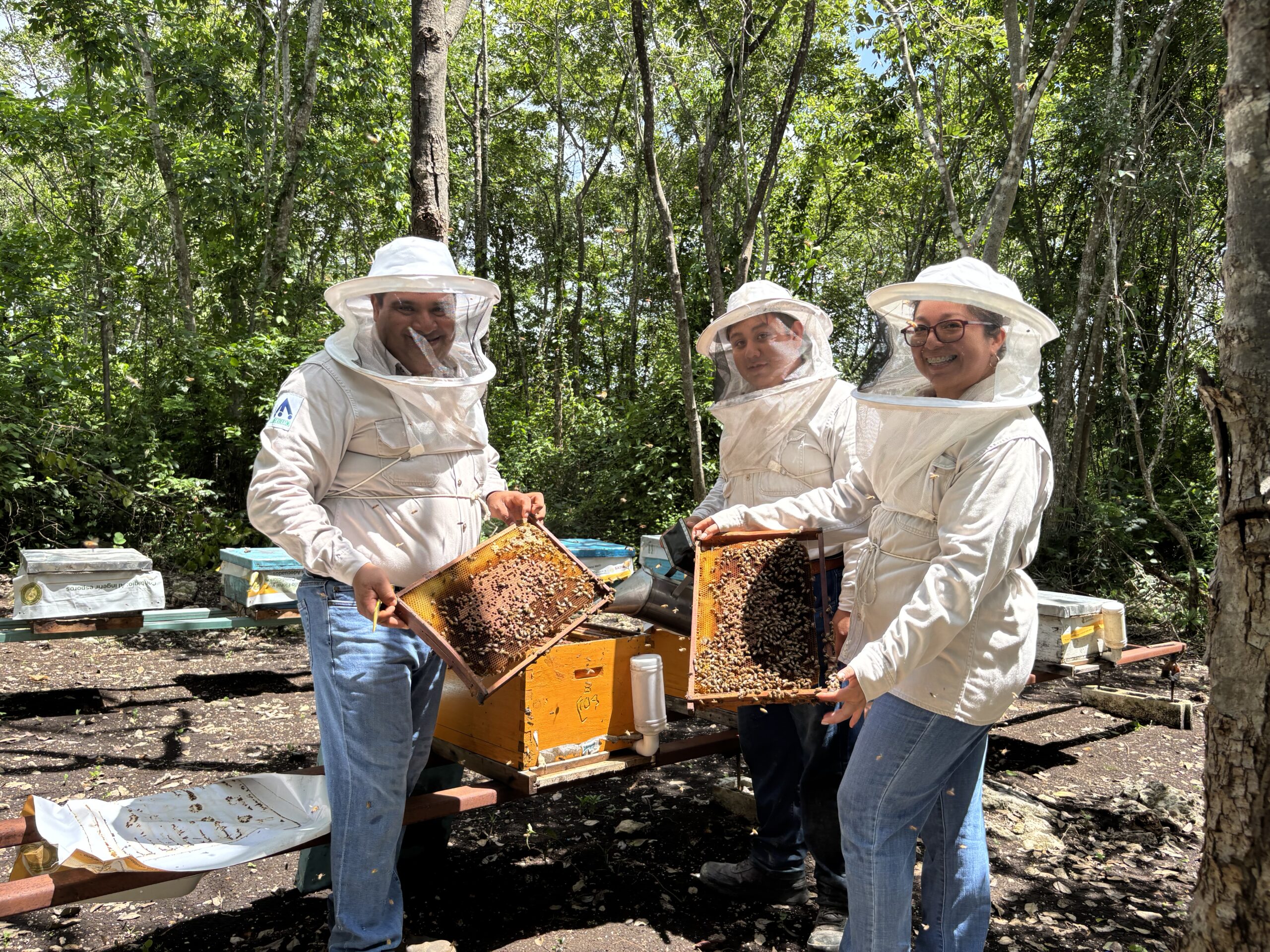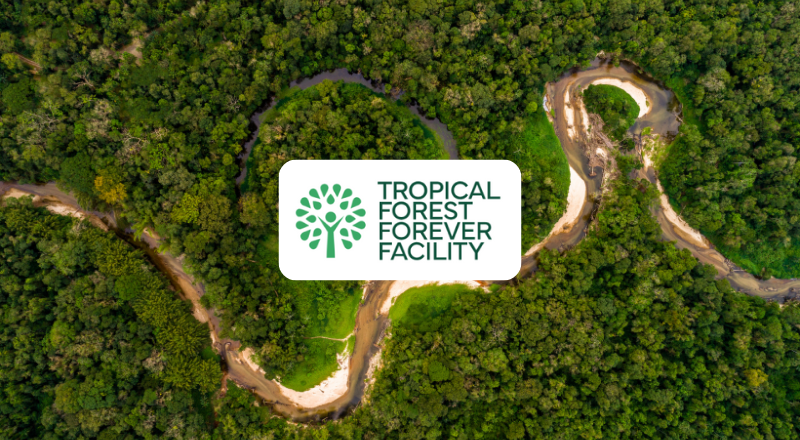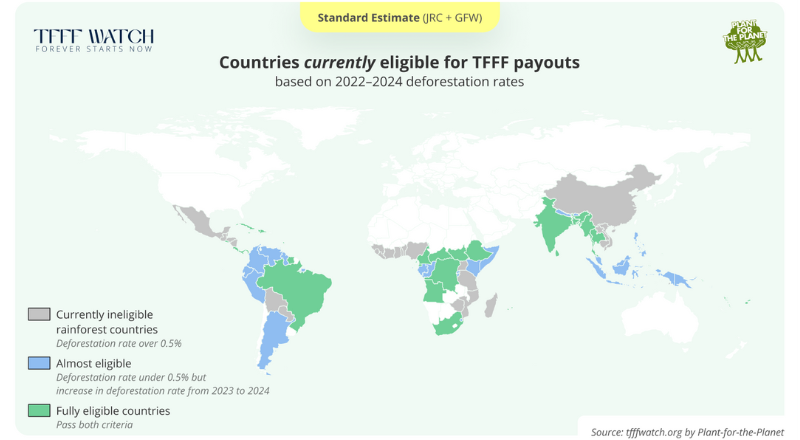
With the Tropical Forest Forever Facility (TFFF), the starting signal for a completely new form of rainforest protection funding is set just ahead of COP 30. Plant-for-the-Planet has developed the TFFFWatch platform, which models the various impacts of the TFFF. In the end, the selected data will determine how and whether distributions are made.
Ahead of the UN Climate Conference on November 6, heads of government will launch the Tropical Forest Forever Facility (TFFF) by signing a joint declaration at the Leaders Summit in Belém.
The TFFF is a proposed investment fund designed to pay for the long-term conservation of tropical forests. Spearheaded by the Government of Brazil, together with eleven other countries.
Unlike traditional conservation finance efforts that rely on continuous donations, the TFFF will invest its capital predominantly in emerging market bonds and use profits from the investments to pay rewards to rainforest countries. The more intact forest a country has, the more money it receives – with large penalties deducted from these payments for ongoing deforestation.
Lighting the road to $25 billion
World leaders are urged to announce their country’s investments into the facility’s junior-debt tranche that will lay the foundation for the facility’s investment capital. So far, Brazil is the only country to have made a firm investment commitment. Indonesia also indicated a $1 billion investment, but details are scarce.
The UAE, the UK, China and Norway may be among the countries committing investments at the launch on Thursday. Germany, the EU and others are potential investors who are likely to support the launch but announce investments later.
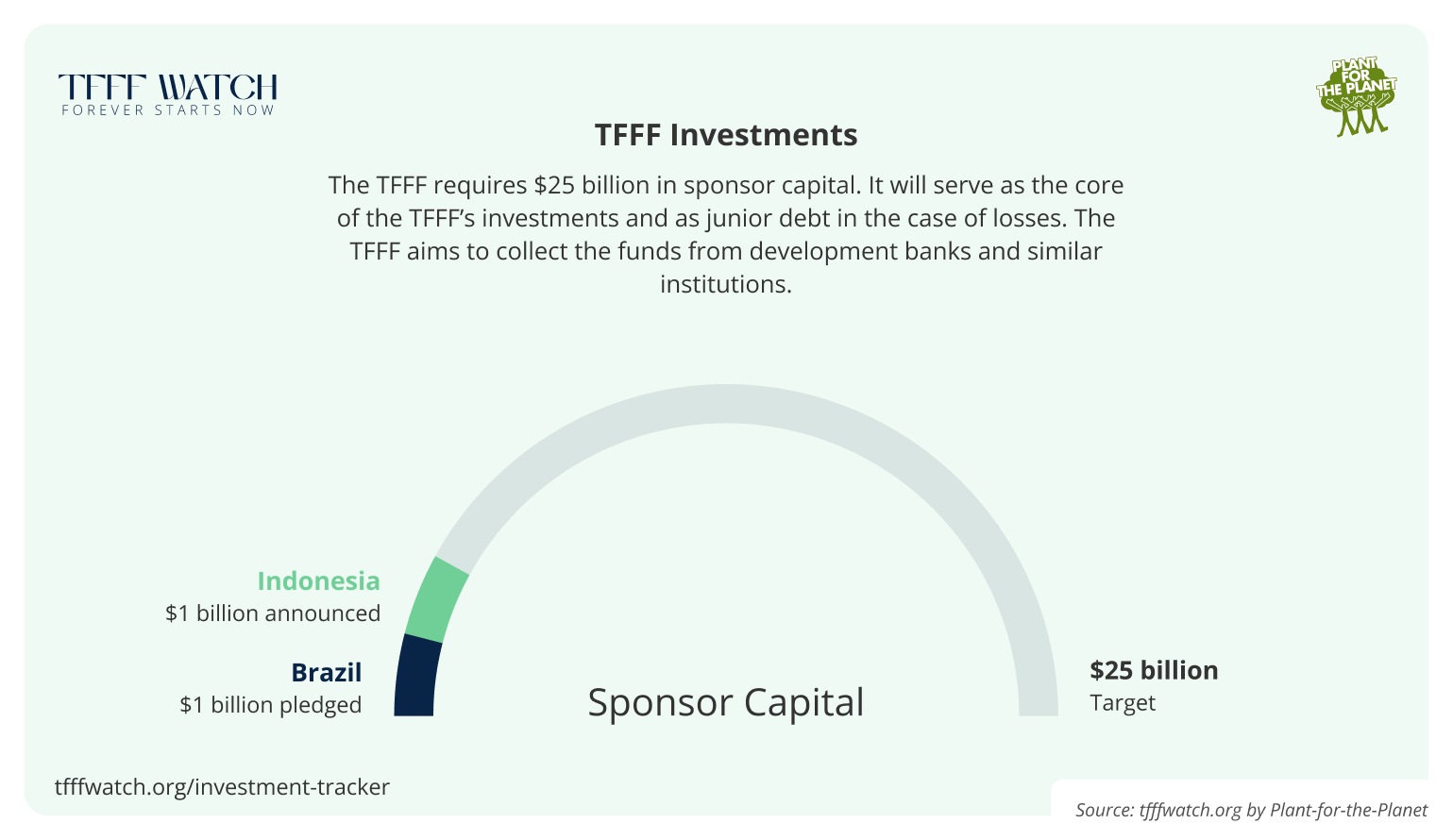
What if fewer than $25 billion are invested?
The TFFF can already begin operating with fewer funds. For every billion dollars in government money, the facility is expected to be able to raise about four billion dollars in investor money.
With half of the government funding, the total investment fund would be only half as large, and disbursements could also be only half as high. The exact amount of payments per hectare has therefore not yet been finalized. For a fully funded TFFF, $4 per hectare is planned.
For our calculation of payments to countries, we assume full funding of the TFFF.
Dueling datasets with billions at stake
Country payouts from the TFFF will be determined by their deforestation and degradation rates, which are measured with earth observation satellites.
But there is some divergence when it comes to how deforestation and degradation are defined; and these definitions could be the difference of hundreds of millions in payouts for certain countries.
There are two commonly used forest-change classifications: Hansen/Global Forest Watch (GFW) and the JRC’s Tropical Moist Forests (JRC). The two systems are based on the same satellite data (Landsat constellation), but their different forest definitions mean they come to substantially different results.
One extreme example: Myanmar has three times as much TFFF-eligible forest in the GFW model as in the JRC model – for many other countries, the differences are negligible.
Unfortunately, neither model’s definitions of deforestation and degradation perfectly match the TFFF’s definitions. Some of the issues include:
- JRC only maps tropical forests. Sub-tropical forests, which are to be included in the TFFF, are not mapped.
- According to TFFF rules, only forest areas with at least 20–30 % canopy cover are considered as eligible forest. The JRC model does not allow the exclusion of forest below the threshold.
- GFW on the other hand maps tree-cover-loss rather than deforestation. Therefore, it also shows loss for areas where forest cover is not permanently lost. This results in a likely over-estimate of deforestation.
In light of these challenges, we adapted the models to create two estimates of how much money rainforest countries would receive from the TFFF:
- Our first Tree-cover-loss Estimate is entirely based on an adaptation of the GFW dataset.
- Our more advanced Standard Estimate, adapts JRC data to estimate tropical forest change and GFW data for subtropical forest change.
We published the Tree-cover-loss estimate (GFW) a month ago as part of TFFF Watch beta. The Standard Estimate is new as of today.

“Neither estimate perfectly calculates payouts rainforest countries would receive from the TFFF. The TFFF secretariat has not yet published detailed rules for how forest change is to be calculated, based on which accurate models could be created. But we believe our Standard Estimate is the best currently available data.” – Tushar Bharadwaj, Remote Sensing Scientist at Plant-for-the-Planet
As soon as more detailed TFFF disbursement rules are published, we will adjust our estimates and make them available on the TFFFWatch platform.
Who benefits from the billions? – What the Standard Estimate shows
Eligible rainforests exist in 74 countries (see first map above). Ten countries together hold 78% of the world’s eligible forest and could get about 78% of all payouts.
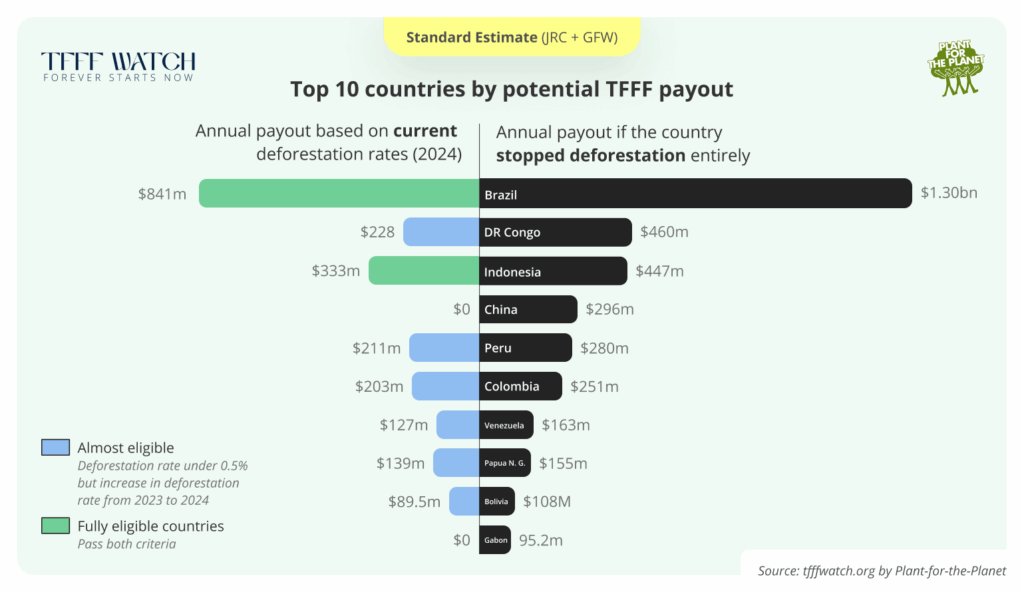
Latin American countries would benefit most from the TFFF. With just over half of all eligible forest, the region’s countries are also eligible for just over half of all potential payouts.
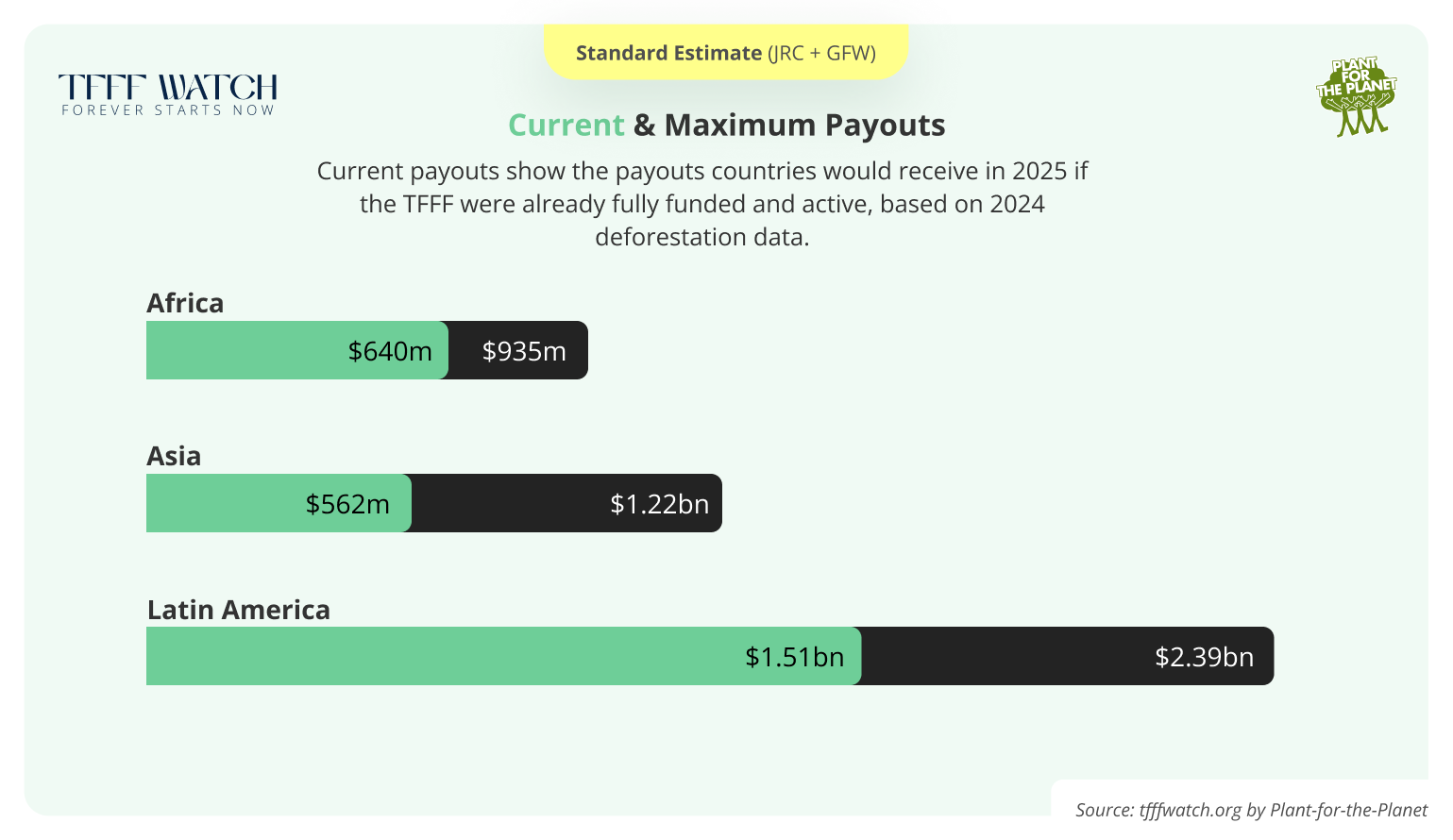
Brazil
No country would receive more than Brazil. Right now, the country would qualify for 31% of the facility’s total global payout.
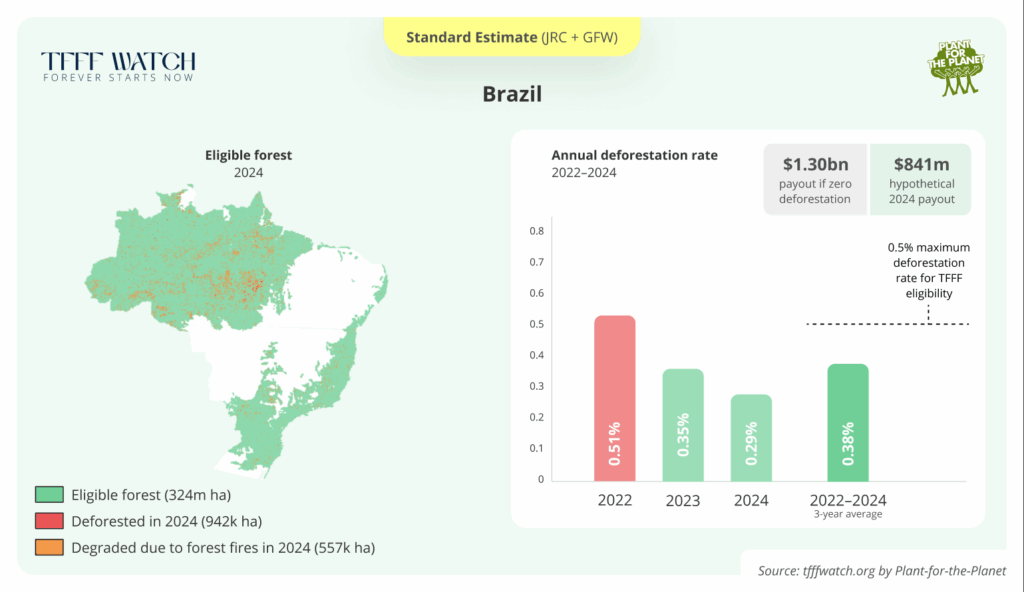
Indonesia
Indonesia could also receive one of the largest payouts (up to $447 million per year), however only if it begins to fulfil the second requirement for joining the TFFF, which is a declining deforestation rate.
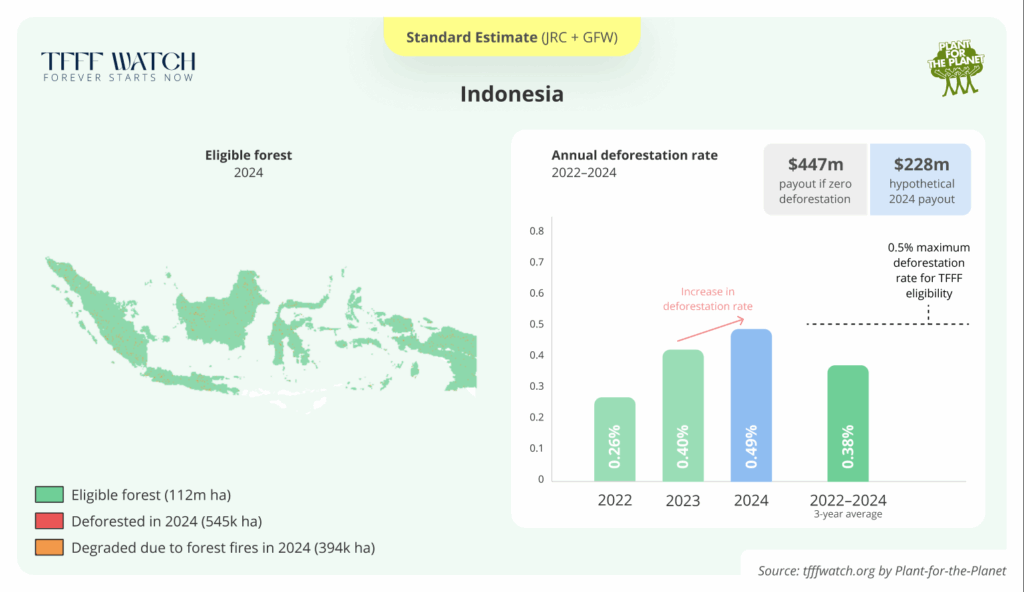
Democratic Republic of the Congo
The Democratic Republic of the Congo has the third-largest eligible forest in the world, and is home to 49% of all eligible forest in Africa, making it another one of the biggest potential beneficiaries (up to $460 million per year).
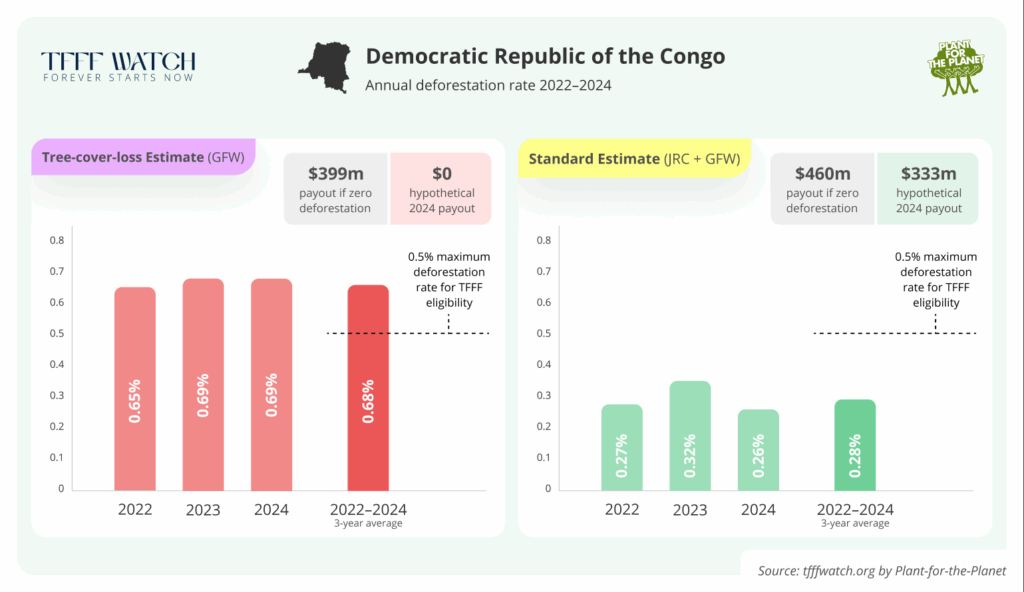
China
China’s deforestation rate remains high, making it ineligible for any payout, which could be up to $296 million per year.
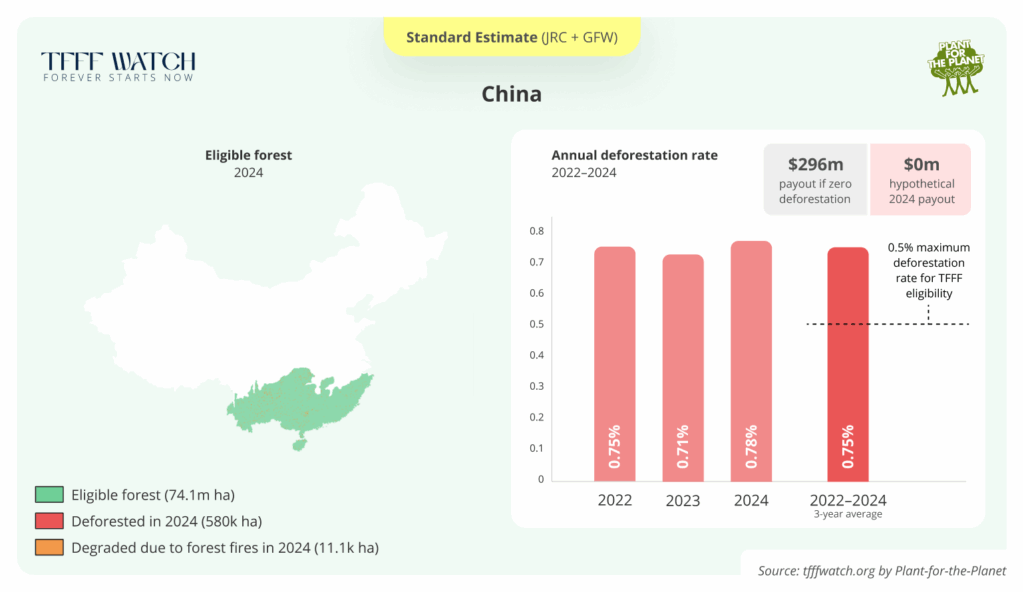
Lowering risk for investor countries
Once fully funded, the TFFF is expected to generate up to $4 billion annually to be used for payments to rainforest countries. However, even under the more generous Standard Estimate, rainforest countries are currently only eligible for about $2.7 billion in payments, based on their deforestation rates. The remaining funds could be added to the investment fund and absorb potential losses, to reduce downside risk for the fund or increase future payouts.
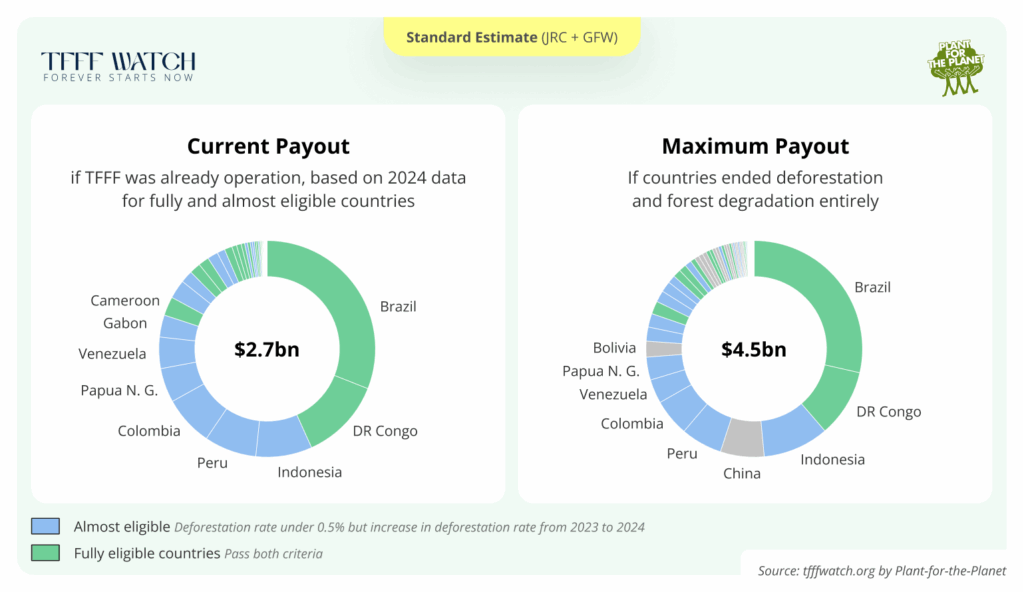
Optimistically, these increased payouts may someday be needed: if all countries fully ended tropical deforestation, they would be eligible for $4.5 billion in annual payments. That slightly exceeds what, current estimates suggest, a fully funded TFFF could generate.
A weak incentive to end degradation?
Countries receive penalties for deforestation and degradation. However, under current TFFF rules, only fire-based degradation is penalized. As a result, we only find about half as much penalizable degradation in rainforest countries than penalizable deforestation.
Penalties for deforestation ($400–$800 per hectare) are much steeper than penalties for degradation ($140 per hectare). As a result, total deforestation penalties are just over six times as high as total degradation penalties. However, countries that cause forest degradation or deforestation are only penalized through deductions from TFFF disbursements. Countries that do not receive any funds from the TFFF are not required to pay any active penalties.
This could lead to countries not taking sufficiently consistent action against forest degradation and focusing solely on combating deforestation in order to maximize TFFF payments.
Limitations of the TFFF Watch data
When using this data, please keep in mind:
- We estimate potential payouts based on current (up to 2024) deforestation data. By the time the TFFF becomes operational, 2025 deforestation data will be available and that will impact which countries are eligible. We will update our estimates as soon as that data becomes available.
- We had to make assumptions in areas where Concept Note 3.1 did not prescribe a detailed methodology.
- Under the TFFF, each rainforest country is to maintain its own data model (that meets the Facility’s technical standards) and submit its results to receive its payout. No such models have been published yet. TFFF Watch is an independent global model.
- In the absence of stringent rules in the Concept Note 3.1 for when degraded forests could be considered intact forests again, regrowing forests were not included in this analysis. As a result, total maximum payouts may be a little larger in the end than calculated here.
Please cite this data as “tfffwatch.org by Plant-for-the-Planet”.
Discover our resources and learn more about the TFFF:
- Visualizations library – We are happy to help with other data visualizations, as needed.
- tfffwatch.org – All data.
- TFFF explainer – detailed explanation.
Media Contact:
Victoria Krumbeck
PR Manager
[email protected] | +49 8808-92108131
